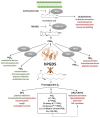Therapeutic Potential of Hematopoietic Prostaglandin D2 Synthase in Allergic Inflammation
- PMID: 31226822
- PMCID: PMC6628301
- DOI: 10.3390/cells8060619
Therapeutic Potential of Hematopoietic Prostaglandin D2 Synthase in Allergic Inflammation
Abstract
Worldwide, there is a rise in the prevalence of allergic diseases, and novel efficient therapeutic approaches are still needed to alleviate disease burden. Prostaglandin D2 (PGD2) has emerged as a central inflammatory lipid mediator associated with increased migration, activation and survival of leukocytes in various allergy-associated disorders. In the periphery, the hematopoietic PGD synthase (hPGDS) acts downstream of the arachidonic acid/COX pathway catalysing the isomerisation of PGH2 to PGD2, which makes it an interesting target to treat allergic inflammation. Although much effort has been put into developing efficient hPGDS inhibitors, no compound has made it to the market yet, which indicates that more light needs to be shed on potential PGD2 sources and targets to determine which particular condition and patient will benefit most and thereby improve therapeutic efficacy. In this review, we want to revisit current knowledge about hPGDS function, expression in allergy-associated cell types and their contribution to PGD2 levels as well as beneficial effects of hPGDS inhibition in allergic asthma, rhinitis, atopic dermatitis, food allergy, gastrointestinal allergic disorders and anaphylaxis.
Keywords: DP receptors; PGD2; allergic inflammation; eosinophilic inflammation; hPGDS; hPGDS inhibitor.
Conflict of interest statement
The authors declare no conflict of interest.
Figures



Similar articles
-
Monocytes and Macrophages Serve as Potent Prostaglandin D2 Sources during Acute, Non-Allergic Pulmonary Inflammation.Int J Mol Sci. 2021 Oct 28;22(21):11697. doi: 10.3390/ijms222111697. Int J Mol Sci. 2021. PMID: 34769126 Free PMC article.
-
Cytokine-induced endogenous production of prostaglandin D2 is essential for human group 2 innate lymphoid cell activation.J Allergy Clin Immunol. 2019 Jun;143(6):2202-2214.e5. doi: 10.1016/j.jaci.2018.10.069. Epub 2018 Dec 19. J Allergy Clin Immunol. 2019. PMID: 30578872
-
Prostaglandin D2 metabolite in urine is an index of food allergy.Sci Rep. 2017 Dec 15;7(1):17687. doi: 10.1038/s41598-017-17798-w. Sci Rep. 2017. PMID: 29247205 Free PMC article.
-
Targeting the PGD2/CRTH2/DP1 Signaling Pathway in Asthma and Allergic Disease: Current Status and Future Perspectives.Drugs. 2017 Aug;77(12):1281-1294. doi: 10.1007/s40265-017-0777-2. Drugs. 2017. PMID: 28612233 Free PMC article. Review.
-
Prostaglandin D synthase: structure and function.Vitam Horm. 2000;58:89-120. doi: 10.1016/s0083-6729(00)58022-4. Vitam Horm. 2000. PMID: 10668396 Review.
Cited by
-
Lipid metabolism gene-wide profile and survival signature of lung adenocarcinoma.Lipids Health Dis. 2020 Oct 13;19(1):222. doi: 10.1186/s12944-020-01390-9. Lipids Health Dis. 2020. PMID: 33050938 Free PMC article.
-
Hematopoietic Prostaglandin D Synthase Inhibitor PK007 Decreases Muscle Necrosis in DMD mdx Model Mice.Life (Basel). 2021 Sep 21;11(9):994. doi: 10.3390/life11090994. Life (Basel). 2021. PMID: 34575143 Free PMC article.
-
Biomarkers in the diagnosis of mast cell activation.Curr Opin Allergy Clin Immunol. 2025 Feb 1;25(1):27-33. doi: 10.1097/ACI.0000000000001046. Epub 2024 Nov 18. Curr Opin Allergy Clin Immunol. 2025. PMID: 39745330 Free PMC article. Review.
-
Unveiling sultam in drug discovery: spotlight on the underexplored scaffold.RSC Med Chem. 2024 Apr 16;15(6):1798-1827. doi: 10.1039/d3md00653k. eCollection 2024 Jun 19. RSC Med Chem. 2024. PMID: 38911171 Free PMC article. Review.
-
Multi-omics in Allergic Rhinitis: Mechanism Dissection and Precision Medicine.Clin Rev Allergy Immunol. 2025 Feb 18;68(1):19. doi: 10.1007/s12016-025-09028-3. Clin Rev Allergy Immunol. 2025. PMID: 39964644 Free PMC article. Review.
References
-
- Song W.-L., Ricciotti E., Liang X., Grosser T., Grant G.R., FitzGerald G.A. Lipocalin-Like Prostaglandin D Synthase but Not Hemopoietic Prostaglandin D Synthase Deletion Causes Hypertension and Accelerates Thrombogenesis in Mice. J. Pharmacol. Exp. Ther. 2018;367:425–432. doi: 10.1124/jpet.118.250936. - DOI - PMC - PubMed
Publication types
MeSH terms
Substances
LinkOut - more resources
Full Text Sources
Other Literature Sources
Medical
Miscellaneous

